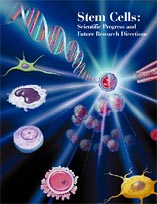FYI from the NHLBI Index
September 2001: Vol. 2, Issue 2
Feature Articles
Message from the Director
This "back to school" season, the NHLBI is providing several opportunities for you to learn how to improve your health. For example, September is National Cholesterol Education Month. The theme this year is "Know Your Cholesterol Numbers - Know Your Risk." It highlights two main points of the new cholesterol guidelines in the Third Report of the National Cholesterol Education Program (NCEP) Expert Panel on Detection, Evaluation, and Treatment of High Blood Cholesterol in Adults (Adult Treatment Panel III, or ATP III): the importance of having your cholesterol measured and knowing your risk of developing heart disease. Many Americans are at high risk of heart attacks because of a combination of cholesterol and other factors; they could benefit from lowering their cholesterol levels even though they don't have especially "high cholesterol." The ATP III Guidelines emphasize the importance of developing personalized risk reduction strategies by setting and attaining target cholesterol levels based on overall heart attack risk.


However, if you or any of your loved ones have the misfortune of experiencing a heart attack, it is crucial that medical care be sought immediately. New medicines can prevent or limit damage from a heart attack, but they are most effective if given within an hour of the onset of symptoms. On National 911 Day, held on September 11, our National Heart Attack Alert Program will launch an aggressive outreach program. Part of the effort will be to educate physicians about the importance of talking with patients about the signs of a heart attack and what to do (call 911) if they think they are experiencing one. But you don't have to wait until your next doctor's appointment to learn about heart attack symptoms. The National Heart Attack Alert Program also is launching a new Web page through the NHLBI's Web site where you can learn how to "Act in Time to Heart Attack Signs."
Sincerely yours,
Claude Lenfant, M.D.
Director
Stem Cells: Scientific Progress and Future Directions

On August 9, President Bush announced that Federal dollars may be used to fund important basic research on human embryonic stem cells. Dr. Ruth Kirschstein, Acting Director of NIH, expressed the NIH community's enthusiastic support of the President's decision, and stated "The approach he has outlined is sound, and we understand the President's clear desire to move forward with care. Using the more than 60 existing cell lines from around the world, many more researchers will now be able to explore the potential of human embryonic stem cells, in addition to the extensive work already sponsored by NIH using human adult stem cells. We believe this combined research has high potential both for opening new doors in basic scientific understanding and for discovery of new treatments for some of our most devastating diseases."
To help you understand what is known, and what is not known, about stem cells, the NIH has prepared a comprehensive, yet comprehensible, report. In addition to a glossary and descriptions of different types of stem cells, the report contains examples of how stem cell research may benefit patients with specific diseases, including conditions affecting the blood or cardiovascular systems. Other chapters describe how stem cells could be used to deliver gene therapies and the safety issues that need to be considered before stem cell-based therapies are developed.
New Rules to Protect Patients' Privacy

Each time a patient sees a doctor, is admitted to a hospital, goes to a pharmacist, or sends a claim to a health plan, a record is made of their confidential health information. When Congress enacted the Health Insurance Portability and Accountability Act of 1996 (HIPAA), which included provisions encouraging electronic transactions and communications, new safeguards were required to protect the security and confidentiality of that information. In response, the U.S. Department of Health and Human Services (DHHS), of which the NIH is a part, recently established "Standards for Privacy of Individually Identifiable Health Information" (also known as the HIPAA Privacy Rule).
Most health plans, health care clearinghouses, and health care providers have until April 14, 2003, to comply with the rule. Then, patients will have significant new rights to understand and control how their health information is used. For example:
- Providers and health plans will be required to give patients a clear written explanation of how information may be used.
- Patients will be able to obtain copies of their records, and to request amendments.
- People will have the right to file a formal complaint about violations of the provisions of this rule or the policies and procedures of the covered entity.
With few exceptions, such as law enforcement needs, an individual's health information may only be used for health purposes. As required by the HIPAA law itself, stronger state laws (like those covering mental health and AIDS information) will continue to apply.

Please send us your feedback, comments, and questions by using the appropriate link on the page, Contact the NHLBI.
Note to users of screen readers and other assistive technologies: please report your problems here.
All Issues | FYI Index | NHLBI Express















 Twitter
Twitter
 Facebook
Facebook YouTube
YouTube